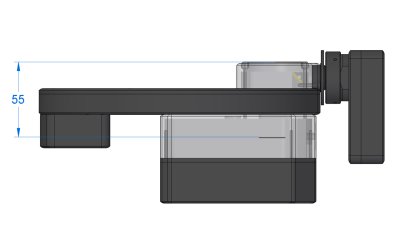|
Both ways of using of guider camera have advantages and
disadvantages.
Standalone guiding telescope often offers shorter focal
length compared to imaging telescope, so it provides wider field of
view and makes finding of bright-enough guiding star easier. On the
other side guider telescope focal length must be long enough to
provide seeing-limited star centroid positions not to limit guiding
quality. Another advantage is that the guiding camera on stand-alone
telescope uses the center of the telescope field of view, where the
image is of the best quality—all optical
aberrations of all telescopes increase with the distance from the
optical axis. The problem is the guiding camera in fact
follows the star in guiding telescope and not in the main telescope.
When both telescope attachment is not rigid enough, optical axes of
both telescopes slightly moves as environment temperature changes,
telescope and the mount orientation changes as the telescope tracks
the sky etc. This means even if the guiding star remains on the same
pixel of guiding camera, image often slowly drifts over the imaging
camera detector. Guiding camera on off-axis guider acquires light from the
main telescope, so no separate guider scope is necessary, which
saves money as well as the weight attached to the mount. Off-axis
guider is mechanically rigid, guider camera follows the same
mechanical distortions of the optical tube and focuser as the main
camera and guiding actions compensate for these
distortions. But if the main telescope has long focal length,
guider camera field of view is small (guider cameras have relatively
small detectors) and bright enough guiding star may not be available
within field of view. Finding appropriate guiding star may require
altering of the telescope position. Also off-axis guider takes the
light from the edge of the field of view, where many telescopes
provide distorted star images. Distortion can limit the brightness
(star image is spread over more pixels compared to properly focused
image) and also affects star centroid calculations.
Either way, with addition of off-axis guider for G2 cameras the
user has both options available. The G2 off-axis guider (OAG) is
designed to allow attachment of any guiding camera with
1.25" eyepiece nose, although the nose must be
somewhat shorter to achieve focus. G0 cameras are designed to achieve
focus with G2OAG and a special shorter version of
1.25" nose with C-mount thread is available for all
G1 cameras. Any camera with CS-mount (short version of C-mount
standard) can use this adapter to be attached to G2OAG.
Off-axis guider on the G2 camera offers T-thread
(M42 × 0.75) and
M48 × 0.75 in proper
55 mm back focal distance. Guider input
is standard 1.25" barrel. The mirror used to deflect light to guiding camera has 10 × 7 mm area (mirror
dimensions are 10 × 10 mm, but the mirror is angled at 45 degrees). This
is enough for guiding cameras with very large 2/3" format detectors
without any significant vignetting (smallest detectors used in G0/G1
guiders is of 1/3" format, but numerous guiding cameras use 1/4" or
even smaller chips).
CAD rendering of G0 (left) and G1 (right) cameras attached
to G2 OAG G0 (left) and G1 (right) cameras on G2 camera attached to
OAG The G2OAG is equipped with standard M42 × 0.75 (T-thread) or M48 × 0.75 on the telescope side in
proper 55 mm back focal distance. This
means G2 camera with OAG can be used on numerous optical systems,
including Newtonian coma-correctors, refractor field flatteners
etc.

Back focus distance is 55 mm for both G2 OAG
variants G2 OAG is manufactured in two variants with different front thread.
Variant with T-thread (M42 × 0.75) allows attachment to many
adapters, this thread is used by a lot of astronomical equipment
manufacturers. But the thread diameter is only 42 mm and the mirror is slightly shielded close to the
upper edge. Adapters with M48 × 0.75 thread are less common, but
offer more space and the mirror is completely illuminated. More and
more manufacturers of correctors and adapters move to the
M48 × 0.75 thread
standard.
G2 OAG with T-thread (M42 × 0.75) and with M48 × 0.75 thread (left), G2 imaging
camera with OAG and guiding camera G1 on telescope
(right) |